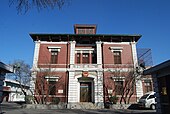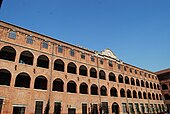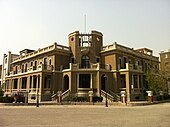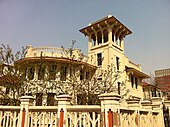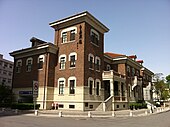|
Italian concession of Tianjin
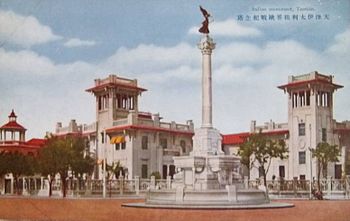 The Italian concession of Tianjin (Chinese: 天津意租界; pinyin: Tiānjīn Yì Zūjiè, Italian: Concessione italiana di Tientsin) was a small territory (concession) in central Tianjin (formerly romanized as Tientsin), China, controlled by the Kingdom of Italy between 1901 and 1943, officially ceded to China in 1947. Characteristics On 7 September 1901, Italy was granted a concession of 46 hectares (114 acres) in Tientsin from the Chinese government. On 7 June 1902, the Italians took control of the concession, which was to be administered by an Italian consul. The Italian Regia Marina ("Royal Navy") stationed vessels at Tientsin such as the river gunboats Ermanno Carlotto and Sebastiano Caboto.[1] In 1917, during World War I, the Republic of China terminated both the German Empire's lease of the German concession of Tianjin and Austria-Hungary's lease of the Austro-Hungarian concession of Tianjin. The two districts were converted into "Special Areas" under Chinese control, with a separate administration from the rest of Tientsin. The Italian concession became the headquarters of the Italian Legione Redenta that fought in 1919 during the Allied intervention against Red Army troops in Siberia and Manchuria during the Russian Civil War. After the end of World War I, Italy requested control of the Second Special Area (the territory of the former Austro-Hungarian concession) and obtained it in 1920,[2] which doubled the size of the Italian concession. Italy returned the Second Special Area to the Chinese authorities when it was in danger of coming under attack and occupation during the Chinese Civil War.[3] In 1935, the Italian concession had a population of about 6,261, including 110 Italian civilians and about 536 foreigners. It was the refuge of many rich Chinese families escaping from Japanese forces after the Second Sino-Japanese War began in 1937.[4] History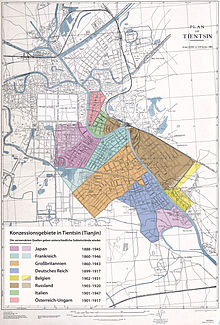   During the Boxer Rebellion in 1900, the Beijing Legation Quarter became the center of an international incident during the Siege of the International Legations by the Boxers for several months. After the siege had been broken by the Eight-Nation Alliance (that included Italy) at the end of the Battle of Peking, the foreign powers obtained the right to station troops to protect their legations under the terms of the Boxer Protocol. In addition, Italy obtained the concession in Tientsin, southeast of Beijing. On 7 September 1901, a concession in Tientsin was ceded to the Kingdom of Italy by the Qing dynasty of China. On 7 June 1902, the concession was taken into Italian possession and administered by an Italian consul: the first was Cesare Poma and the last (in 1943) was Ferruccio Stefanelli. Along with the other foreign concessions, the Italian concession lay on the Pei Ho, southeast of the city centre. In the late 1920s, the Italians even held small forts such as the Forte di Shan Hai Kuan near the Great Wall of China in Manchuria[5] and in Hankow. In 1925, Benito Mussolini created the Battaglione italiano in Cina and quartered it with soldiers of the San Marco Regiment in the new Caserma Ermanno Carlotto.[6] The police were Chinese, while the officers were Italians. There was even a football team in the Italian concession.[7] During World War II, the Italian concession in Tientsin had a garrison of approximately 600 Italian troops.[citation needed] On 9 September 1943, after the publication of the Italian armistice with the Allies, the concession was occupied by the Imperial Japanese Army without fighting and the Italians were interned at Tangshan. In November, they were given the choice to give their allegiance to Mussolini's new Italian Social Republic. Those that did had their personal weapons returned and were used by the Japanese as labour troops.[8] In July 1944, the Italian Social Republic formally relinquished the concession to Wang Jingwei's Japanese-sponsored Reorganized National Government of China which, like the RSI in Axis-held northern Italy, was not recognized by the Kingdom of Italy, the Republic of China, or most other nations.[9] The Wang Jingwei government fell when the Empire of Japan was defeated. At the same time, the Italian commercial concessions in the Shanghai International Settlement, Hankou, and Beijing were ceded to the Republic of China.[citation needed] On 2 June 1946, the Kingdom of Italy became the Italian Republic and, on 10 February 1947, by virtue of the peace treaty with the Allied powers, the Italian concession was formally ceded by Italy to Chiang Kai-shek's Republic of China.[citation needed] GovernorsDuring the Italian presence, the following governors succeeded each other:[10]
See also
Notes
Bibliography
|
||||||||||||||||||||||||||

